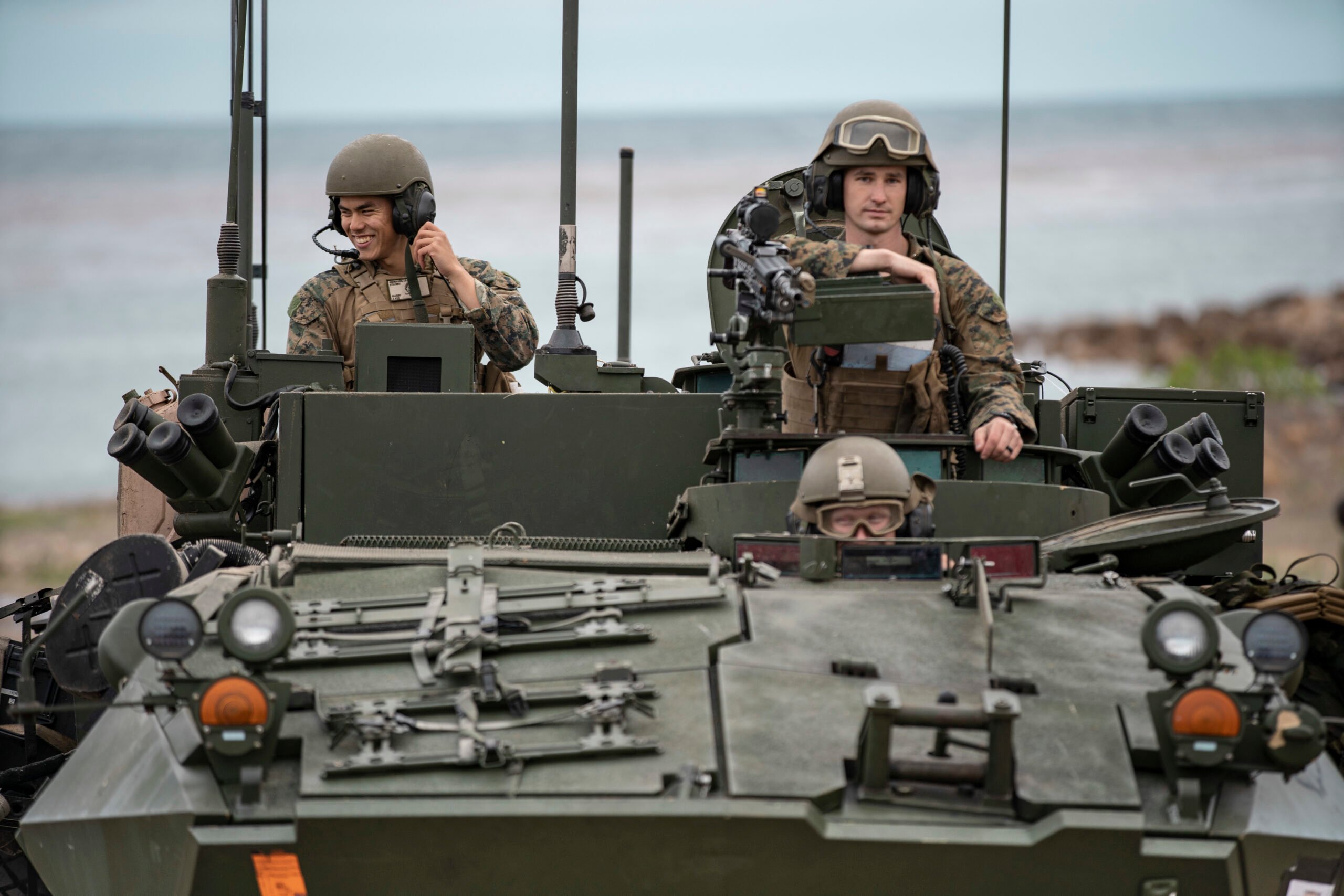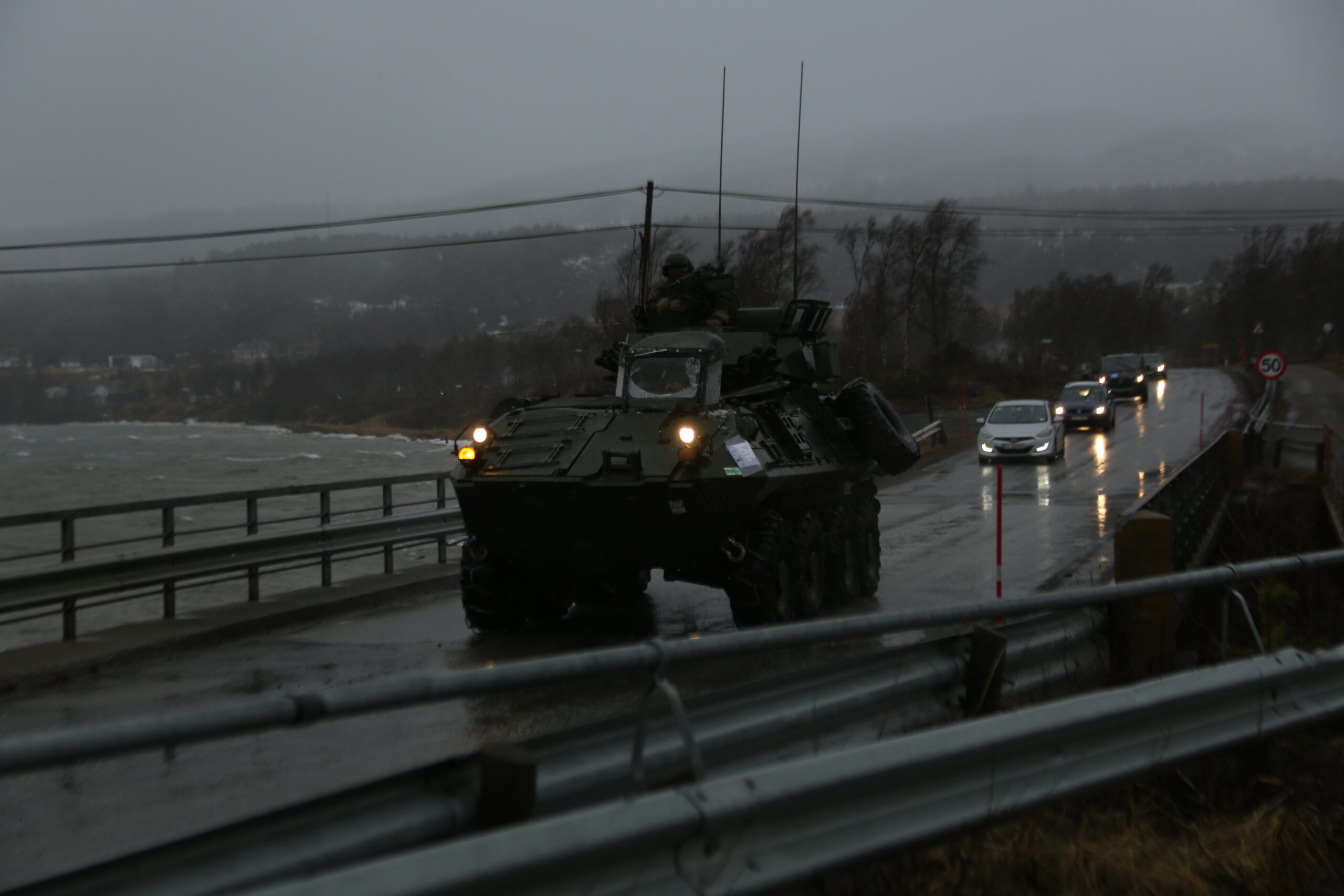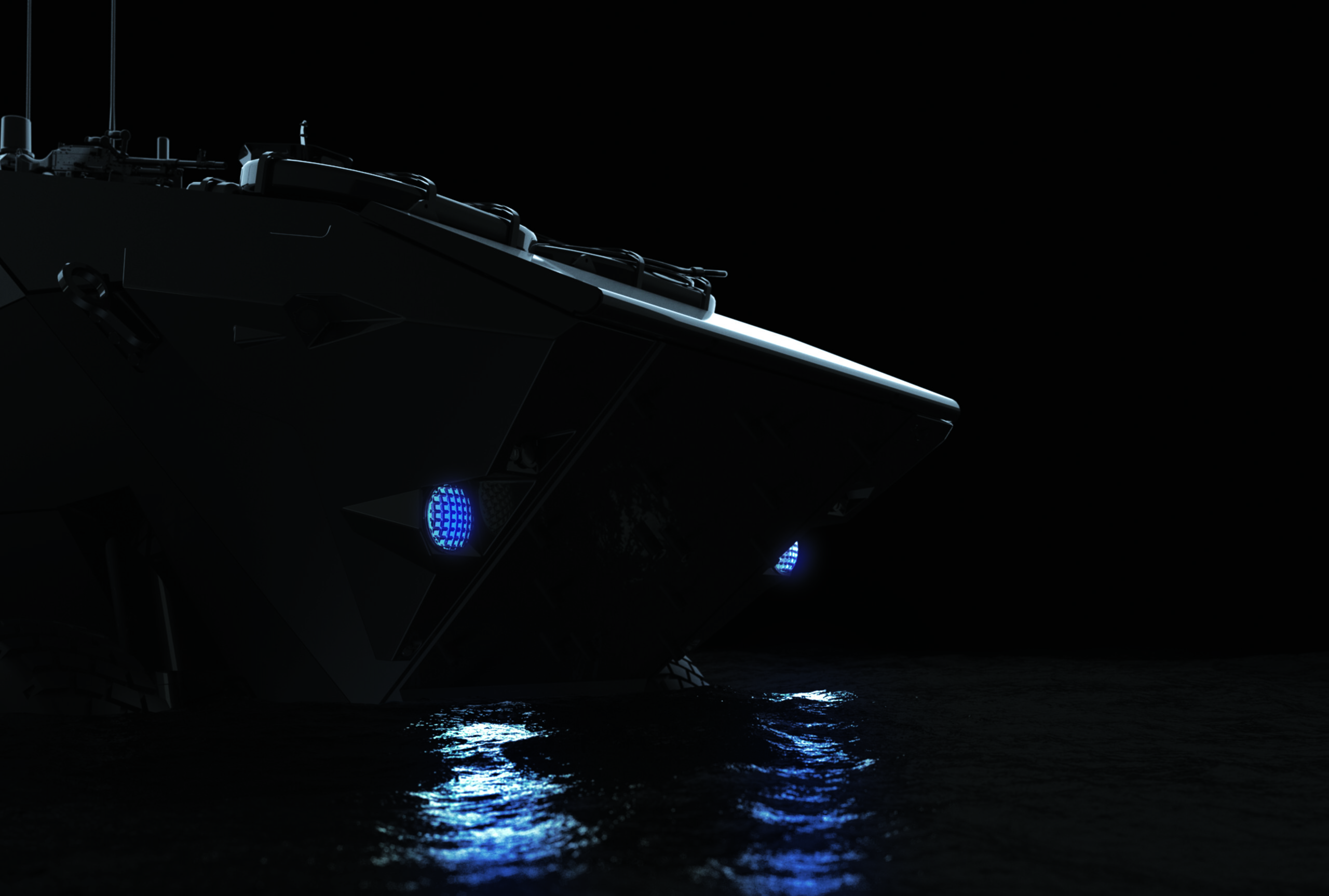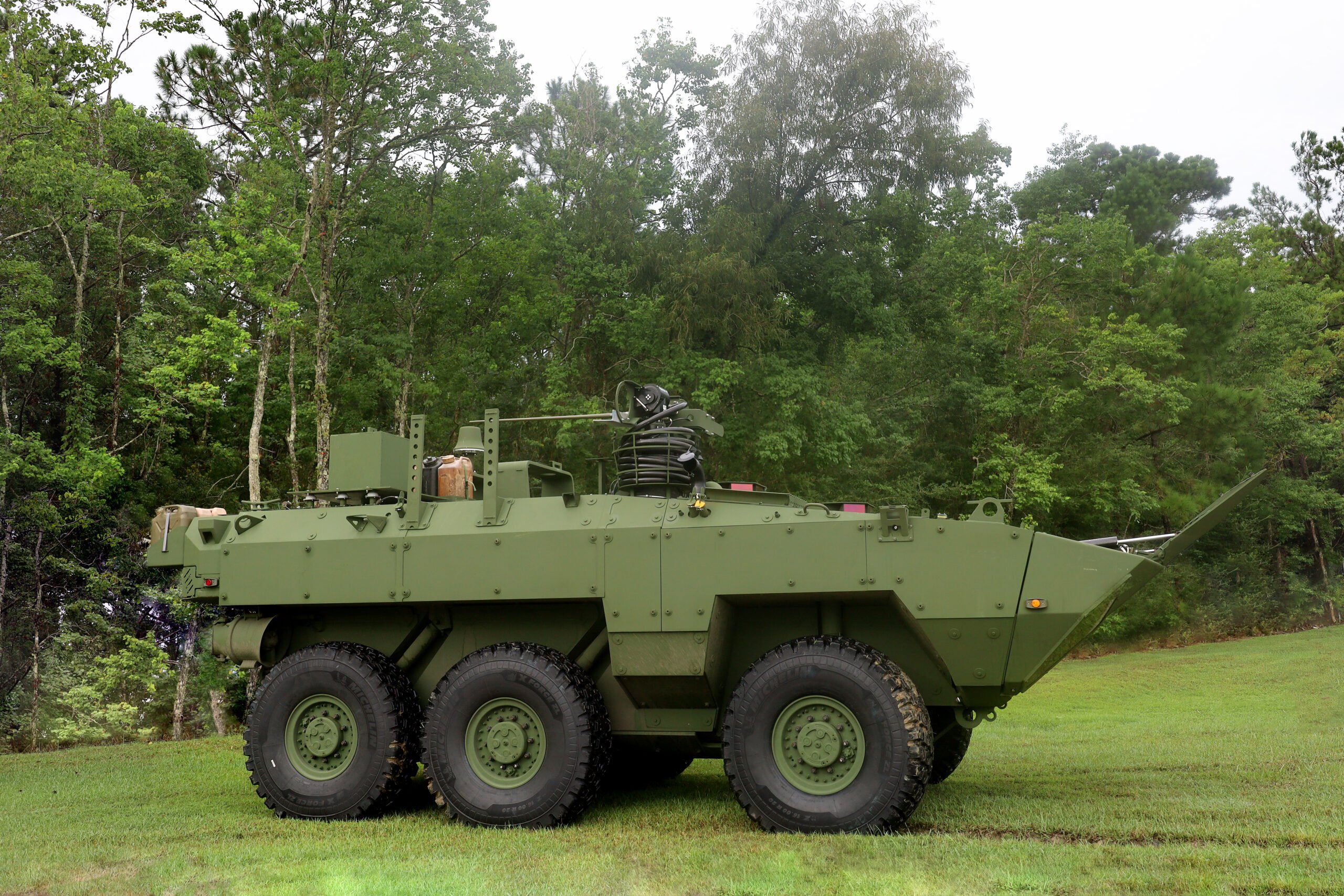
US Marines operate a Light Armored Vehicle after coming ashore during an expeditionary advance base exercise, May 15. The Advanced Reconnaissance Vehicle will replace the LAV after the latter has served the Marines for four decades. (U.S. Marine Corps photo by Sgt. Alexis Flores)
Editor’s Note 01/23/24 at 2:00p ET: In 2024, Breaking Defense published an updated story about the Advanced Reconnaissance Vehicle that clarifies certain information about the Marine Corps’ program schedule.
WASHINGTON — As the Pentagon increasingly focuses on the primacy of battlefield information through its Joint All Domain Command and Control efforts, the Marine Corps’ quest for a new reconnaissance vehicle is focused not just on traditional battlefield intelligence gathering, but the ability to ingest and process data from across the joint force.
Now, after five years of technology demonstrators and other preliminary efforts, the service has two companies — General Dynamics Land Systems and Textron Systems — on track to deliver their final versions of the Advanced Reconnaissance Vehicle (ARV) to the service for evaluation in December. An announcement declaring a winner is not expected to come until late next year, but just last month the companies put prototypes through swim testing to make sure they are ready for the end-of-year deadline, executives said.
With a contract worth up to $6.8 billion at stake for the prevailing bid and amid some skepticism of the program from the very top of the Corps, Breaking Defense spoke to both vendors to understand what they hope the ARV will bring to the fight and how the new combat vehicle intersects with two emerging Pentagon interests: information warfare and unmanned systems.
“The Advanced Reconnaissance Vehicle (ARV) is imperative to realizing Marine Corps requirements for Fleet Marine Force 2030,” the services wrote of the program in its latest budget request to lawmakers. “As part of the portfolio of reconnaissance, surveillance, and target acquisition systems, ARV will be a purpose-built combat vehicle system, highly mobile on land and water, that can sense, communicate, and fight as the manned hub of a robotic and autonomous systems-enhanced team.”

A Light Armored Vehicle from 2nd Light Armored Reconnaissance Battalion, drives across a bridge in Brøstadbotn, Norway, March 13, 2014 as part of exercise Cold Response 2014. (Photo by Staff Sgt. Steve Cushman)
A Focus On Command And Control, And UAVs
The ARV’s core purpose is to replace the Marine Corps’ Light Armored Vehicle fleet, a program that has served the Marines since the 1980s and was built by General Dynamics.
The LAV program is scheduled to sundown in the mid-2030s, right after the brand new ARV is scheduled to “full operational capability,” the Pentagon’s final acquisition milestone signifying the military’s confidence that the ground vehicle is completely tested, proven and ready for combat.
The Marine Corps is interested in six variants of the ARV each with unique roles: command, control, communications and computers-unmanned aerial system (C4/UAS); organic precision fire-mounted; counter UAS; 30mm autocannon and anti-tank guided missile; logistics; and recovery. (Separately, the Corps has also put BAE Systems, the prime contractor for another program, the Amphibious Contract Vehicle, under contract to study how the C4/UAS package used on the ACV could be equipped on the ARV.)
Perhaps in a sign of its importance to the Corps, the ARV competition winner will be determined by which company the Marines choose based on the C4/UAS variant of the vehicle. Later the service will work with the winning firm to make the other five variants.
The Marines refer to the C4/UAS variant as the “battlefield quarterback” because the intent is to have an ARV capable of ingesting the massive amounts of data that will be moving across Pentagon and Marine Corps networks as well as help Marines make decisions in the moment based on the information they receive.
Two Teams With Deep Histories In The Pentagon, Abroad
Phil Skuta, a General Dynamics executive overseeing the company’s ARV bid, said the core difference between the ARV’s predecessor, the LAV, and ARV is the ability to ingest data.
“You basically have 40-year-old technology,” he said of the LAV. You don’t have “operational awareness really beyond line of sight… Here, we’re talking about a true expansion of being able to sense and detect the enemy on the battlefield tens of miles outside” the ARV’s line of sight.
That focus on ingesting, analyzing and allowing Marines to act on data from throughout the battlefield is core to the Pentagon’s JADC2 efforts, and more specifically, the Navy’s branch of it, routinely called Project Overmatch.
Navy officials have been tight lipped about what exactly their Overmatch efforts include — the program’s chief said that silence is meant to keep adversaries guessing — but the notion behind Overmatch revolves around sharing data from platform to platform. The earliest iterations of the technology were scheduled to be put on some aircraft carriers late this year.

A General Dynamics Land Systems executive said his company’s submission for the ARV competition is “optimally suited” for operating in the Indo-Pacific. (Photo courtesy of General Dynamics.)
One way the Marines hope to feed ARV data about what is going on around it is an unmanned aerial system capable of being deployed potentially as far as 30 miles away from the vehicle. A focus for the competition, the executives said, was gaining a clear grasp on how that drone will integrate with the ARV.
“Understanding how that flight will take place and then bringing that data back into the ARV and turning that data into useful information to base — whether it’s your reconnaissance decision or other decisions off of [it] is what we mean by integrating the unmanned aerial system capability,” Skuta said.
In General Dynamics’ favor in this competition is their history with the program. The company is effectively the incumbent as the makers of the LAV and has taken part in technology demonstrators since 2019. The company is also coming into this competition having recently picked up a separate $1.14 billion Army contract for the Mobile Protected Firepower vehicle.
“ARV [has] to be small, mobile, survivable platform that can operate in multiple areas of the globe, and especially in those littoral areas [and] coastlines as the Marines have staked a lot of their future concepts in the Indo-Pacific region,” Skuta said. “We think our vehicle is suited optimally for those type of tactical areas to be operating in.”
Despite the history, Skuta said their ARV candidate is a “clean sheet” design, meaning it was created from scratch.
Likewise, Textron senior executive for land and sea systems David Phillips told Breaking Defense their offering, called the Cottonmouth, was a “clean sheet” design, despite that company having other Army contracts as well.

Textron’s “Cottonmouth” vehicle will be its submission for the Marine Corps’ Advanced Reconnaissance Vehicle program. (Photo provided by Textron Systems)
During an interview, Phillips stressed that Cottonmouth is not derived from the company’s M117 Armored Security Vehicle, which has been bought by the US Army as well as international customers, nor the Commando vehicle, a variant of the M117.
He also said the combination of C4 and unmanned systems integration makes this first variant of the ARV particularly complex. But naturally, he added, his company’s bid was made with the Marines’ needs in mind.
“Where we believe Textron Systems coming with a clean sheet design on this thing really brings value to the Marines is we’ve got a very unique background and history in both ground combat vehicle development and manufacturing, but also in systems integration… in multiple domains across” manned and unmanned systems, he said.
In addition to the M117 and Commando vehicles, Textron is also responsible for the Shadow and Aerosonde unmanned aerial systems, both of which are used by the Pentagon, and the Marine Corps’ new Ship-to-Shore Connectors, medium-sized vessels designed to transport Marines and their equipment from deep blue water ships through shallow waters and ultimately onto land. The familiarity with the latter is important because a key requirement for the new ARV is to be a weight and size that allows four of them to be transported on one Ship-to-Shore Connector.
“We wanted to … make sure that from a durability and really reliability standpoint, we were building a solid vehicle and certainly from [a] size and transportability [perspective], keeping really mindful of four systems on a Ship-to-Shore connector,” he said. “We know how important that is for the Marines in transporting things through the littoral and onto the shore.”
That familiarity with the Ship-to-Shore Connector’s capabilities combined with the company’s wider portfolio of unmanned systems integration is sure to play to its favor in the final bid.
A Skeptical Eye On The Program, From The Top
Once both bids are submitted to the Marines in December, the service plans on announcing a winner around fall of 2023. If all goes according to plan — not something that is ever surefire in the world of Pentagon acquisition — the next Advanced Reconnaissance Vehicle will be ready for real world operations around 2030.
The service has deemed the ARV as “critical towards the modernization of Marine Corps reconnaissance capability,” according to the Navy’s fiscal 2023 budget justification documents. But, like every other major acquisition program in the Pentagon, not everyone is fully convinced. In this case, the skepticism is from the Marine Corps’ top officer.
“While I have repeatedly stated that all-domain reconnaissance and counter-reconnaissance will be a critical element of any future contingency, I remain unconvinced that additional wheeled, manned armored ground reconnaissance units are the best and only answer – especially in the Indo-Pacific region,” Commandant Gen. David Berger wrote in his initial Force Design 2030 rollout. “We need to see more evidence during Phase III to support this conclusion before engaging in an expansion of our existing capacity, or committing billions of dollars in procurement funds towards the acquisition of an Advanced Reconnaissance Vehicle (ARV).”
With that in mind, the general has since directed in his May 2022 update to Force Design that the Marine Corps “review and validate all assumptions” regarding the ARV. In other words, Berger wants the service to consider the changing winds at the Pentagon and make certain this program is still going to produce a product worthy to fight in 2030.
Despite Berger’s comments though, the ARV program is still rolling along and for the competition’s winner, it will be an opportunity to solidify its place in the Marine Corps’ future ground vehicles portfolio.






















